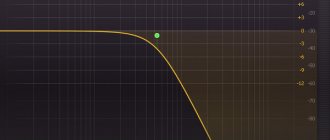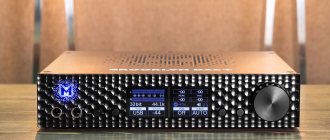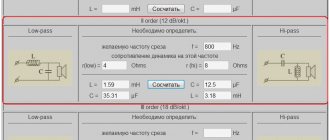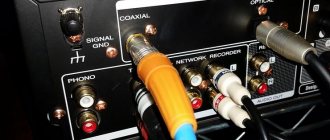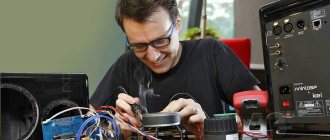Sampling frequency
(or
sampling rate
, English
sample rate
) - the sampling frequency of a time-continuous signal when it is sampled (in particular, by an analog-to-digital converter). It is measured in Hertz.
The term is also used for inverse, digital-to-analog conversion, especially if the sampling frequency of the forward and inverse conversion is chosen differently (This technique, also called “Time Scaling,” is found, for example, when analyzing ultra-low-frequency sounds made by marine animals).
The higher the sampling rate, the wider the spectrum of the signal that can be represented in the discrete signal. As follows from Kotelnikov's theorem, in order to uniquely restore the original signal, the sampling frequency must be more than twice the highest frequency in the signal spectrum.
Some of the audio sampling rates used [1]:
- 8,000 Hz - telephone, enough for speech, Nellymoser codec;
- 11,025 Hz - a quarter of an Audio CD, sufficient for speech transmission;
- 16,000 Hz;
- 22,050 Hz - half Audio CD, enough to transmit radio quality;
- 32,000 Hz;
- 44 100 Hz - used in Audio CD. Selected by Sony for reasons of compatibility with the PAL standard, due to the recording of 3 values per line of the frame image × 588 lines per frame × 25 frames per second, and sufficiency (according to Kotelnikov’s theorem) for high-quality coverage of the entire range of frequencies distinguishable by humans by ear (20 Hz - 20 KHz);
- 48,000 Hz - DVD, DAT;
- 96,000 Hz - DVD-Audio (MLP 5.1);
- 192,000 Hz - DVD-Audio (MLP 2.0);
- 2,822,400 Hz - SACD, a single-bit delta-sigma modulation process known as DSD - Direct Stream Digital, jointly developed by Sony and Philips;
- 5,644,800 Hz - Double sample rate DSD, one-bit Direct Stream Digital with twice the sample rate of SACD. Used in some professional DSD recorders.
What is Sample Rate (Sampling Rate)? What is bit depth?
When a signal enters the ADC from a preamplifier, compressor, console output, or synthesizer, it represents electromagnetic oscillations. That is, a certain wave with a changing voltage of very small values comes to the input of the ADC.
The result is a wave graph on a computer screen. Even the best converter has an error, because there are no intermediate values between zero and one, and the wave graph will consist only of vertical and horizontal segments, without inclined lines.
The graphical drawing of the wave will be influenced by the pitch of the sound, frequency of vibrations, its timbre, waveform and volume, amplitude. A high-quality ADC must correctly transmit all these parameters to the recording system. So, sound enters the system discretely, that is, divided into small sections. The accuracy of encoding an analog signal in a digital environment depends on the size of these segments. The smaller the horizontal and vertical discrete units, the more accurate the digitization.
The horizontal splitting of a wave gives us an idea of the sampling rate, or sampling rate. The more often the ADC records changes in wave graph values, the higher the sampling frequency. Actually, one sample is a discrete unit segment, a minimal unit of sound.
The shorter it is, the higher the sampling rate. For example, the value of the sampling frequency in Each sample is equal in duration to the previous one. For correct sound reproduction, the sample rates of the file and the system must be identical. When adding an audio track to a project with a sampling rate different from that of the host program, it must be converted. If you play a higher frequency file on a lower frequency system, it will sound slower than it should, and vice versa.
Amplitude-frequency response
In this topic one cannot fail to mention such a concept as frequency response. What it is? This is a diagram that characterizes the dependence of the amplitude of sound on its frequency. Using it, you can determine at which frequencies the speaker can play louder and at which frequencies quieter.
The ideal chart looks like a straight line with a slight downward slope at the beginning and a slight upturn at the end. Alas, it is difficult to achieve such indicators, so only Hi-End class acoustic systems have such a diagram.
In other cases, I recommend choosing speakers based on their frequency response, depending on what sound you prefer:
- With a rise from 20 Hz to mid-bass for those who like to “boom” - fans of drum'n'bass, breakbeat, dubstep, death metal, grindcore and some doom metal movements;
- With a predominance of mid frequencies - for fans of classical vocals and music;
- High frequencies - for fans of heavy metal, power metal, and pig scream vocals.
To the logical question of how to change the frequency response of an acoustic system, the only adequate answer is to re-solder it yourself, replacing the base speakers with more suitable ones. However, many music lovers know how to increase high frequencies and remove bass.
The first way is to use the controls on the speaker system itself. If these are not provided by the design, I recommend listening to music using a player with a built-in equalizer - for example, WinAMP or AIMP.
So, we figured out what the frequency response affects. I would also like to note that most often in the accompanying documentation for acoustics in the budget segment, such a diagram is not provided.
It is found in the middle class and more expensive devices. However, many manufacturers provide all the necessary data for each device on the official website.
Digital audio path: upsampling and upscaling, WASAPI, ASIO and external master clock for USB audio
But this is just a guess. I have never come across a single device that did not support 48 kHz or did not recommend using 48 kHz for some reason. It’s clear that I’m still a long way from writing a game for the PlayStation, but that doesn’t matter. The main thing is that I found out that you need to work at 48 kHz. Don’t forget also that the oldfags care deeply about these high frequencies of yours. The auditory cochlea gradually dies with age, starting from the upper end, and a person loses range.
Model Neumann U 87 Ai
A high-quality and technologically advanced model designed for professional studio recording. Some experts consider this device as the standard of studio microphones today. The device is distinguished by several polar patterns, including circular, figure-of-eight and cardioid. And if the “Shur” microphone in the SM-58 modification is, rather, designed to use one specific spectrum of sound coverage, then in this case the user can use the selector to select the most suitable configuration in narrow directions. In addition, it is possible to cut frequencies and reduce the signal. This concerns the processing of the lower spectrum.
If we talk about design features, they are expressed in an increased size of the membrane, the use of a new generation XLR3F connector, as well as a switchable 10 dB attenuator. This model is also ideal for amateur tasks, since the ergonomics of setup and control are implemented according to the traditional scheme. But there is also a drawback that this microphone has. The price of the device is about 220-230 thousand. For this reason, this modification is mainly used by large music studios and television companies that need to provide high-quality clear sound.
Dear visitor!
When a signal enters the ADC from a preamplifier, compressor, console output, or synthesizer, it represents electromagnetic oscillations. That is, a certain wave with a changing voltage of very small values comes to the input of the ADC. The result is a wave graph on a computer screen. Even the best converter has an error, because there are no intermediate values between zero and one, and the wave graph will consist only of vertical and horizontal segments, without inclined lines. The graphical drawing of the wave will be influenced by the pitch of the sound, frequency of vibrations, its timbre, waveform and volume, amplitude. A high-quality ADC must correctly transmit all these parameters to the recording system. So, sound enters the system discretely, that is, divided into small sections. The accuracy of encoding an analog signal in a digital environment depends on the size of these segments.
Speed of sound in km per hour and meters per second
The speed of sound is the speed at which waves propagate in a medium. Below I give a table of propagation speeds in various environments.
| 0 ºС | m/s | km/h |
| Air | 331 | 1191.6 |
| Hydrogen | 1284 | 4622.4 |
| Nitrogen | 334 | 1202.4 |
| Ammonia | 415 | 1494.0 |
| Acetylene | 327 | 1177.2 |
| Helium | 965 | 3474.0 |
| Iron | 5950 | 21420.0 |
| Gold | 3240 | 11664.0 |
| Oxygen | 316 | 1137.6 |
| Lithium | 6000 | 21600.0 |
| Methane | 430 | 1548.0 |
| Carbon monoxide | 338 | 1216.8 |
| Neon | 435 | 1566.0 |
| Mercury | 1383 | 4978.0 |
| Glass | 4800 | 17280.0 |
| Carbon dioxide | 259 | 932.4 |
| Chlorine | 206 | 741.6 |
The speed of sound in air is much less than in solid media. And the speed of sound in water is much higher than in air. It is 1430 m/s. As a result, propagation is faster and audibility is much further.
I’m writing an MP3 disc, which frequency is more profitable: 44.1 or 48?
A few words about the composition, operation and optimization of the digital audio path using a computer and USB. Basically, the topic is boring and there are a lot of letters, so if it’s difficult to master, go straight to the conclusions. An audio signal, in general, is encoded by a sequence of signal amplitude values measured at regular intervals.
Not only for beginners, but also for some enthusiasts who have been involved in sound for many years, it will seem like a revelation that the banal recording process is accompanied by the most complex physical phenomena. One of these is called discretization. By definition, it is the process of converting a continuous function into a discrete one. It is difficult for people far from science to understand this, especially since quantum physics is involved here - the most complex of those existing today. But professional sound engineers, for example, those working in the Moscow recording studio "Interval", know what the audio sampling frequency is and which is best applicable in certain cases. Why? Because the final quality of recorded music depends on this phenomenon. During the cassette-film period, these nuances were omitted due to limited technical equipment. But in today's high-tech digital world, audio sampling rate matters when creating music and presenting it to listeners.
Dynamic or ribbon microphone for vocals?
The working basis is a combination of an inductor and a sensitive element in the form of a membrane. During the action of the sound signal, the voltage in the coil changes under the influence of the membrane itself with its vibrations. Moreover, the coil operates under conditions of a constant magnetic field. This is the optimal microphone for voice, which is designed for use during concerts. The design is distinguished by its massive body and the presence of a special mount for holding in the hand. As for the operating properties, they focus on live recording while ignoring off-axis sounds.
A good mic will definitely have a high rejection of the "pops" and don't even neglect them, they shouldn't be ferocious because they can't be easily treated later in post-production. Instead, handheld transmitters are only transmitters capable of interacting with many types of microphones, but also with audio signals from different sources. In addition to the radio functions below, you should also check whether the transmitter can receive audio without powering the microphone or whether it connects to both two-wire and three-wire microphones, as well as the input sensitivity adjustment range.
Tape-type models, on the contrary, have a fragile design and a more sensitive internal filling, which is oriented towards more accurate and detailed signal processing. Instead of a membrane, such a microphone uses a thin ribbon, due to the vibrations of which the voltage readings change. The operation of the tape device is characterized by soft responsiveness, which allows it to be used more effectively in sound recording, not only of voices, but also of musical instruments. However, a microphone for studio recording can also be found in lines with dynamic models. Usually these are universal devices, thanks to the settings of which you can solve different problems.
Obviously the same considerations apply to a microphone amplifier just below that in the transmitter the maximum sound level that is applicable is one that would be 100% modulation, beyond this limit there will be unacceptable distortion.
They are very convenient transmitters because in this case the choice of microphone is completely free. For example, it could be connected to a handheld microphone and turned into an "ice cream" microphone, it could be connected to a shotgun microphone for complex sound repetition, etc. etc. The description of the electrical characteristics is similar to the characteristics of the pocket transmitter, but in this case the audio input stage is different. A handheld transmitter is preferred for these microphones. Those transmitters that have an input transformer are advantageous because they are usually more immune than the common mode noise that is generated if we use a very long audio cable between the microphone and the transmitter.
If we talk about working with recording instrumental sounds, then you should pay attention to specialized modifications. For example, the same dynamic microphones are available in versions for drums, tom-toms, wind instruments, etc. Typically, such modifications are provided by a wide range of regulation parameters, both in sensitivity and in the direction of signal capture.
It's good to check the type and life of the battery because this type of microphone, even if it has an external microphone with 48V phantom power, has limited battery life. Let's quickly see the audio features that a good radio microphone should have. Dynamic range, i.e. the amplitude ratio between the highest signal before distortion and the background noise of a radio system. Obviously, the higher the value, the better the radio microphone; a good radio microphone significantly exceeds the dynamic range of 100 dB. There are also radio microphone systems that include more than one compression system, and the user can select the one that best suits the specific situation. The best performance won't break. . This is a tip for those who use these systems frequently: adjusting the audio level is important for both easy and quick access, since during recording you often have to change this setting, and if you find it, you are confused in the endless menus and submenus, it becomes long and difficult, and in the meantime the sound is poorly recorded.
Detailing of concepts
What is bit depth and sampling frequency, which is better? The answer to this question, despite the complexity of the nature of these phenomena, can be obtained. There is no need to study physics textbooks. Suffice it to remember that Soviet semi-underground sound engineers recording rock and other music determined these indicators on an intuitive level. Discretization is also called sampling. This definition is more understandable for musicians. Its frequency implies the intensity of the processes at the moment when the analog signal is converted to digital. These include data storage, conversion, and direct digitization.
The sampling rate is measured in hertz. The guideline in its study is Kotelnikov’s theorem. Its author reveals the essence of discretization. According to the theorem, it limits the intensity of the digitized signal to half its own value.
Sampling frequency. What is its significance for sound recording?
Time sampling is a process that is directly related to the conversion of an analog signal to a digital signal. Along with it, the data is quantized by amplitude. Time sampling means measuring a signal at the time of its entire transmission. One sample is taken as a unit. If this is not entirely clear in words, then with an example it looks more convincing. Let's say the discredit frequency is 44100 Hz - the same one that was used on audio CDs. This means that the signal is measured 44,100 times within one second.
An analog signal is always superior to a digital signal in its saturation. And its transformation is an inevitable loss in quality. The sampling frequency serves as a kind of guideline: the higher it is, the closer the digital sound quality is to analog. This is clearly visible in the list below. It shows which sound frequency is better. Studying it, you will see the direct relationship between sampling and track quality:
- 1. 8000 Hz. This frequency is typical for telephone conversations and speech recording on a voice recorder with a simple set of functions. Used on audio converted through the Nellymoser codec.
- 2. 22050 Hz is used in radio broadcasting.
- 3. 44100Hz. As mentioned above, this frequency is typical for Audio CD, and this indicator has long been identified with the highest level of quality. And today the format does not lose its position.
- 4. 48000 Hz. These are DAT and DVD formats, which replaced AUDIO.
- 5. 96000 – DVD-audio MLP-5.1.
- 6. 2822 400 Hz – high-tech SACD Super Audio format.
The list clearly indicates which sound frequency is best. In addition, technology does not stand still, and new formats are emerging. But before making far-reaching plans, you should take into account one very significant nuance. Its essence is simple: the higher the sampling frequency, the more difficult it is to achieve technologically. To do this you need:
- ensure high intensity transmission of digital streams. But this is not possible on every interface. And the more channels are involved in recording (and this is typical for musical ensembles), the more complicated the process;
- have a processor capable of performing powerful computing operations. But even in the most modern samples, the possibilities for obtaining ultra-high quality sound are limited;
- use computer equipment with a large amount of RAM for recording.
Considering the above information, it is not surprising that the sound frequency of 44100 Hz continues to be the most popular today. It has been satisfying even the most demanding quality requirements for decades, and at the same time there are all the technical capabilities to achieve it. The last factor is decisive both for ordinary users and for most recording studios. Even knowing which sound frequency is best, in order to achieve it, you need to take care of the technical equipment.
Lethal sound level
I would like to mention a little about the lethal sound level for humans. It starts at 180 dB
and higher.
It is worth saying right away that according to regulatory standards, a safe noise level is considered to be no more than 55 dB (decibels) during the day and 40 dB at night. Even with prolonged exposure to hearing, this level will not cause harm.
| Sound volume levels | ||
| (dB) | Definition | Source |
| 0 | It's not loud at all | |
| 5 | Almost inaudible | |
| 10 | Almost inaudible | Quiet rustling of leaves |
| 15 | Barely audible | rustling leaves |
| 20 — 25 | Barely audible | Whisper of a person at a distance of 1 meter |
| 30 | Quiet | The ticking of a wall clock ( permissible maximum according to standards for residential premises at night from 23 to 7 o'clock ) |
| 35 | Quite audible | Muffled conversation |
| 40 | Quite audible | Normal speech ( the norm for residential premises during the day from 7 to 23 hours ) |
| 45 | Quite audible | Talk |
| 50 | Clearly audible | Typewriter |
| 55 | Clearly audible | Conversation ( European norm for class A office premises ) |
| 60 | Noisy | (the norm for offices ) |
| 65 | Noisy | Loud conversation (1m) |
| 70 | Noisy | Loud conversations (1m) |
| 75 | Noisy | Scream and laughter (1m) |
| 80 | Very noisy | Scream, motorcycle with muffler |
| 85 | Very noisy | Loud scream, motorcycle with muffler |
| 90 | Very noisy | Loud screams, freight railway car (7m) |
| 95 | Very noisy | Subway car (7 meters outside or inside the car) |
| 100 | Extremely noisy | Orchestra, thunder ( according to European standards, this is the maximum permissible sound pressure for headphones ) |
| 105 | Extremely noisy | On old planes |
| 110 | Extremely noisy | Helicopter |
| 115 | Extremely noisy | Sandblasting machine (1m) |
| 120-125 | Almost unbearable | Jackhammer |
| 130 | Pain threshold | Airplane at the start |
| 135 — 140 | Contusion | Jet plane taking off |
| 145 | Contusion | Rocket launch |
| 150 — 155 | Concussion, injuries | |
| 160 | Shock, trauma | Shock wave from a supersonic aircraft |
| 165+ | Rupture of eardrums and lungs | |
| 180+ | Death | |
Model Sennheiser MK 8
The German manufacturer Sennheiser is rather known for traditional acoustic equipment, as well as headphones for professional and amateur use. But successful microphones often appear in the families of this brand. In particular, a good microphone made by MK 8 can be used both at home and in studio recording. This is a double diaphragm condenser model, characterized by accurate and soft sound transmission. To maximize vocal performance, the developers have provided the ability to use omnidirectional, extended, supercardioid and standard cardioid polar configurations.
Another noteworthy feature of the model. The fact is that the MK 8 user has the opportunity to adapt any type of mixer to the audio path through a three-stage attenuator. In general, the set of accessories included with this model made the device almost universal, in any case, this applies to the channels for connecting the model to third-party equipment in addition to the mixer. High-quality filtration systems also deserve special attention, which, if necessary, can eliminate both the mentioned effect of approaching the sound source and the impact of structural noise. In general, we can say that this is a technologically advanced, functional and simply high-quality microphone. The price of the model, however, is also rather large and amounts to about 50 thousand.
Types of microphones
The most popular types of microphones are dynamic and condenser. The advantage of the first type is that it does not require an external power source, in addition, its design is quite simple. The operating principle is based on vibrations of the membrane, which are then transmitted to a conductor passing through a magnetic field.
The dynamic type of microphone is often used for concerts and live performances. It is also used in recording studios. There are also models of such microphones that are specially designed for special instruments - for example, for various drums.
The action of a condenser microphone is based on changing the capacitance of the condensate located between the plates that are affected by sound. This type of device requires an external power supply. Such microphones are best suited for studio work (for sound recording), since they transmit sound with the highest quality and clarity.
However, they are very sensitive to external conditions - humidity, ambient temperature, distance to the sound source, as well as to extraneous sounds. Because of this feature, their use in “field” conditions is excluded. However, there are models of this type that can be used for live performances, for example, choral singing. Condenser microphones must be mounted on special holders.





